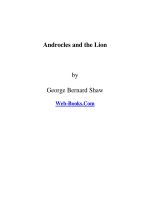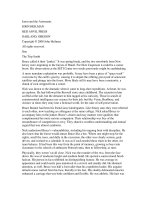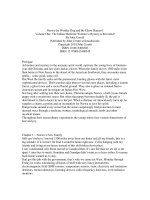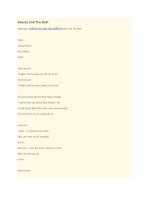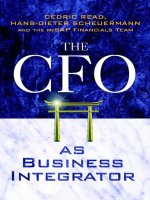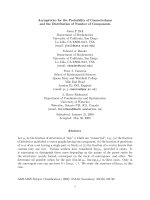Jason and the Astronauts
Bạn đang xem bản rút gọn của tài liệu. Xem và tải ngay bản đầy đủ của tài liệu tại đây (95.96 KB, 11 trang )
Jason and the Astronauts
JOHN HEILMAN
RED ANVIL PRESS
OAKLAND, OREGON
Copyright © 2008 John Heilman
All rights reserved.
One
The Trip South
Bruce called it their “junket.” It was spring break, and the two snowbirds from New
Jersey were migrating to the forests of Brazil. For Nick Casperson it could be a career
boost. His observations at the SETI Center two weeks previously might be earthshaking.
A more mundane explanation was probable. It may have been a piece of “space trash”
overcome by the earth’s gravity, causing it to depart the orbiting graveyard of senescent
satellites and plunge into the forest. More likely still it may have been a meteorite, a
chunk of rock stripped from a comet.
Nick was drawn to the dramatic when it came to long-shot expeditions. At heart, he was
an explorer. He had followed the Roswell story since childhood. The scientist in him
scoffed at the tale, but the dreamer in him tugged at his curiosity. Those in search of
extraterrestrial intelligence use science for their job, but like Verne, Bradbury, and
Asimov at times they stray into a fictional world, for the sake of self-preservation.
Bruce Bonner had been his friend since kindergarten. Like binary stars they were tethered
to each other, now teaching as colleagues at the same college. Nick asked Bruce to
accompany him on the junket. Bruce’s charm and easy manner were qualities that
complemented his more serious companion. Their relationship was free of the
encumbrance of competition or envy. They shared a wordless understanding and mutual
regard that was almost symbiotic.
Nick understood Bruce’s vulnerabilities, including his ongoing bout with discipline. He
also knew that the forest would attract Bruce like a bee. Where one might stop for the
sights, smell the roses, and dally in the excursion, the other was clearly serious, goal-
driven, and worked to a schedule. It was as if each needed these traits in the other, for
team balance. It had been this way from the point of memory, growing as boys into
classmates in the schools of anthracite Pennsylvania, then to fellowship, as men.
Physically, they weren’t at all close. Nick was the rounder of the two, from the face
down. He was of moderate height and medium build. He sported a sand-colored brush
haircut. His person in fact exhibited no distinguishing feature. He was average in
appearance and could easily pass unnoticed in a crowd, and usually did. He shunned
attention, as well. Bruce was half a foot taller than his expedition leader. His angular
attractiveness carried from his face, literally to his feet. His sleekly delineated muscles
enhanced a carriage that was both confident and flexible. He was athletic. His hair was
dark brown and full. His lips were relaxed and the subtle squint of his brown eyes
suggested a hint of sarcasm behind his relaxed manner.
Officially, Bruce was an instructor at the college. His biology labs were popular with
students, and his sense of adventure had stretched the chancellor’s permissiveness. In
fact, his relationship with Throckmorten was strained, and it was only through Nick’s
insistence that Bruce was included. To travel with his friend, and perhaps help him make
a significant discovery would be reward enough. To spend nine magical days in the
paradise of a diverse Brazilian rain forest had been a lifelong dream.
Something violent happened on the plateau north of Manaus, the capital city of Amazonia
and the world’s former rubber Mecca. The region did not lie on that part of the so-called
Ring of Fire, known as the Pacific Rim, where the Nazca and South American plates
meet along the west coast of South America. An earthquake was unlikely. Besides, the
Survey’s seismographic recording showed neither P nor S waves characteristic of quakes.
Instead, the record suggested a surface shock as the initial disturbance, with ripples
followed by blips, indicating fallout. Whatever it was, it had set off the sensors that
comprise the Geological Network in South and Central America. Bruce impishly
remarked it might have been Chuck Yeager breaking the sound barrier for the Brazilian
Air Force. He saved that for Nick, after finishing his interview with Throckmorten. Nick
appreciated it was impossible to examine in detail the records of every geologic event
around the globe, particularly in remote spots. The oceans swallow up most
extraterrestrial matter. His own interests were tuned both to the radio universe and to
highlighted data garnered from the U.S. Geological Survey.
What riveted Nick’s attention most was a report from the huge radio telescope at
Arecibo, Puerto Rico. The Garden State Observatory and its Center devoted to the search
for extraterrestrial intelligence was located on the Jersey side of the Delaware River
watershed in the mountains. The Center possessed a twenty-inch optical refractor and a
small radio dish with which it participated in the all-sky survey known as the Argos
Project. The Center also had access to data from the SETI Institute in California.
The institute provided data from three radio observatories: the Very Large Array in New
Mexico, Arecibo’s huge stationary dish in Puerto Rico, and the 2.3-acre moveable
Greenbank dish in the mountains of West Virginia.
The mysterious finding that evening in March was a fleeting signal picked up at Arecibo.
Its Doppler analysis showed a “blue shift,” indicating the source was moving toward the
earth at a velocity of around Mach 3. The 10-kilohertz signal was picked up virtually at
the same time as the shockwave in the Brazilian forest was recorded. Were the two
observations connected? Were they coincidental? Was one an artifact? Were they both
artifacts? Double skepticism was wagered against the miniscule chance of a historic
event.
Nick’s fascination with Roswell had inspired his interest in the U.S. Geological Survey
and earth surface events. He felt he wouldn’t have much competition for this hunt, since
most scientists scoffed at the idea of alien visits to earth. They made the argument of
distance, and it was compelling. The universe was thought to have a radius of 10 billion
light-years. Over two hundred planets had been discovered, orbiting stars fifty to two
hundred light-years away, suggesting there were millions more. The star 61 Cygni was
only ten light-years away. Flying a spaceship with current technology at a cruising speed
of ten miles a second, or 1/18,600th the speed of light, it would take two thousand
centuries to get to this star. We’d have to find a wormhole or develop a speedster that
would close in on c, the speed of light. Our modern spaceships were jalopies, in
comparison.
But maybe others had solved this limitation. If they’ve come, they likely hadn’t spotted
our signal. Our calling cards aboard the Pioneer and Voyager probes had now gone thirty
light-years’ distance, give or take a few billion miles. Our oldest radio broadcasts had
traveled out roughly ninety light-years. Frank Drake, the father of radio astronomy,
predicted a half-century ago that many planets existed beyond our solar system. This had
now been confirmed. Physicist Enrico Fermi once asked over lunch, “Where is
everybody?” He was referring to life that was both intelligent and technically advanced.
Nick and hundreds of searchers like him still asked the same question. Search methods
were improving with the pace of computers, doubling in capability every eighteen
months. The Kepler space telescope slated for launch in 2008 would continuously look at
one hundred thousand stars for the transit of an earth-sized planet. Still, it was a
frustrating enterprise. A secret part of Nick was ablaze with confined anticipation.
It had been with some urgency that Nick approached the grant committee. The college
accelerated their passport and visa processing. Vaccinations were arranged. The handling
of paperwork was streamlined, and Nick agreed to complete his expedition within a
narrow time frame. With competent guides using rivers for transport, he promised to
produce some answers at the end of the nine-day spring break.
The travel agent for the college set up the itinerary. It involved a red-eye Varig flight
from Miami to Rio de Janeiro. The following morning they would fly into the old delta
town of Belem and meet their first host, a man called Raphael De Sanctos. Raphael was
the owner operator of the Para River Transport Company and would fly them to the
interior city of Manaus, where they would launch on the massive Rio Negro, with their
second guide.
In its short history, the college had sent only two other faculty members to South
America for research. An anthropologist once pawed around Machu Picchu for Incan
remains and a poli-sci don had spent some time studying the origins of Chile’s
constitutional government.
The packing crate required two men to carry it. They checked the crate and their duffels
through to Belem, on northern Brazil’s Atlantic coast. Bruce’s part of the gear was
Spartan. To his minimal clothes list he added a three-piece fly rod. He had done this,
mindful of once when he curbside checked his new graphite on the front end of a fly-in
fishing trip to Canada only to have it pilfered, leaving him with only the memory of its
impressive action. Bruce carefully tracked the duffels and crate into the hold on this first
leg.
Once they were airborne Bruce signaled a neatly dressed stewardess. She waved off a
nearby male attendant and appeared next to Nick, who occupied the aisle seat. She leaned
over the space between them, causing Nick to sink back in his seat.
“May ah help you, sir?”
“Yes, you may. Can you please see to it that we have as much quiet as possible? The
professor here is trying to study his charts.”
She smiled as she looked at Nick and the map spread across the empty seat. Then she
turned and puffed up a pillow for an elderly woman across the aisle. Nick shot a quizzical
glance at Bruce.
“Bruce, old man, don’t kid around with these people. You’ll scotch the whole trip. Flying
these days is a serious thing, in case you’ve never flown before.”
“I know her Nick. She’s got a fine sense of humor.”
The man diagonally across the aisle turned and smiled faintly at both of them.
“You’d better know her very well.”
The prim stewardess returned.
“Mr. Bonner, would eitha you or the professor theya like a newspaper?”
“Would you happen to have Vogue, or Mademoiselle?”
“Ah am so sorry…no, but there are some fashions featured in the Airline Magazine in
that pouch in front of you. If you need anything, just push that little button, up theya. Oh,
I’m sorry, Professor…”
She turned to attend a woman with a fussy child.
“Okay, Bruce, you’ve impressed me. Your reputation is probably international. By the
way, what’s her name, and how long have you known her, if I may ask?”
“Christine. We chatted while I got held up in first class and you were stashing your carry-
on. I went over the routine with her then. Told her you needed peace and serenity.”
“Thanks for your consideration. And she just played along?”
“Without fee, Kemo Sabe. Lighten up. I don’t want you to burn out, the first night.”
“Roger, Tonto.”
Bruce winked at Christine when she shot by en route to the galley.
Nick settled in to his review. The sector maps of the forest wilderness north of Manaus to
the Venezuelan border included topographic relief, seasonal rain data, the names of
rivers, parks, and escarpments, as well as general locales of indigenous peoples. Nick had
looked over the inventory several times. It included a two-man tent with mosquito
netting, sleeping bags, plastic sterile bottles for taking specimens and samples, two army
collapsible shovels, a core sampler, survival kits, a half dozen disposable waterproof
cameras and batteries plus Nick’s digital, rain gear, Dacron pants and aerated long-
sleeved shirts, wide-brimmed hats, waterproofed and worn-in hiking boots, lots of
sunblock and insect repellant, trail mix and dried fruit, a chart depicting regional
poisonous snakes and frogs, Bruce’s fishing gear, a simple dictionary of Portuguese
terms, a satellite transponder telephone, antibiotics and a first aid kit with anti-
dysenterics, Tylenol with codeine pills, chloroquine, and a record of their recent
vaccinations. The friendly folks at the local Public Health Department had dutifully shot
them up with vaccines against cholera, yellow fever, hepatitis A, and typhoid.
Somewhere over the Smokey Mountains Nick fell asleep and Bruce began reading the
book Nick loaned him. When they deplaned in Miami, Bruce was careful to assure
Christine they had a most pleasant ride. She invited them both to fly her friendly sky
again.
During their layover at Miami International, Bruce bought some polarized sunglasses, the
kind that accentuates greens and yellows of the forest. He had used them while fishing
once. For him they provided a poor-man with a cheap psychedelic experience, especially
when accompanied with music. Bruce also brought his iPod. A swingman’s hat bearing
the logo of the Royal Flying Doctor’s Service finished out his shopping spree at MIA. He
drooped the hat around the back of his neck.
“Nice hat. Where did you find it?”
“It’s from the Land of Oz.”
“Have you brushed up your Strine?”
“Hey, for our next trip we can visit that satellite tracking station on the mountain out
there in Alice.”
“Let’s make the best of this one first. I have just one request, so far.”
“Yes, Professor?”
“Give the ladies a break on this trip, Casanova.”
“Alrite mate, but the shielas are out there just the same. Do you know what you are
asking, Monsenior?”
Nick nodded and rolled his eyes.
The flight to Rio was bumpy. Bruce read further into Tomlinson’s The Sea and the
Jungle. It was a little-known book that Nick plucked from his explorer collection. It had
been written by a man who took his own dare. In 1909, he quit his newspaper job in
Wales, kissed his wife and kids good-bye, and boarded a coal-loaded steamer bound for
the remotest outposts of the upper Amazon. After three years of high adventure, he
returned and resumed his former life. His family had remained in place. Nick assigned it
neither as a hint, as Bruce had no family, nor as an endorsement of wanderlust. The
autobiography contained a valid description of the region, and perhaps things hadn’t
changed that much. Bruce made heady progress before the chardonnay overtook him.
Nick was careful to keep a clear head. He mused most of his waking hours. He thought of
the Roswell incident. He had written a paper about it in grade school, where it was then
better received than any reference might bring at the college, today. The story had made a
big splash at the time, before astronomers knew as much about the size of the Cosmos.
He had once attended the annual alien jamboree in Roswell, which had become the
“Groundhog Day” of the Southwest.
No matter which version one accepted, something crashed out there in the desert of New
Mexico, in 1947. When a cowboy reported it to the town’s sheriff, who in turn reported it
to the military, things quickly got dicey. The Army condoned off the area and secrecy set
in, big time. Two debris fields said to contain strange materials were officially attributed
to a downed weather balloon. Nick knew that the Japanese during WWII sent seven
